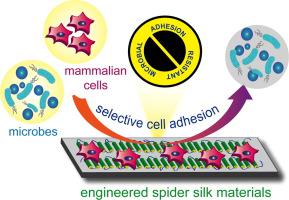当前位置:
X-MOL 学术
›
Mater. Today
›
论文详情
Our official English website, www.x-mol.net, welcomes your
feedback! (Note: you will need to create a separate account there.)
Engineered spider silk-based 2D and 3D materials prevent microbial infestation
Materials Today ( IF 21.1 ) Pub Date : 2020-12-01 , DOI: 10.1016/j.mattod.2020.06.009 Sushma Kumari , Gregor Lang , Elise DeSimone , Christian Spengler , Vanessa T. Trossmann , Susanne Lücker , Martina Hudel , Karin Jacobs , Norbert Krämer , Thomas Scheibel
Materials Today ( IF 21.1 ) Pub Date : 2020-12-01 , DOI: 10.1016/j.mattod.2020.06.009 Sushma Kumari , Gregor Lang , Elise DeSimone , Christian Spengler , Vanessa T. Trossmann , Susanne Lücker , Martina Hudel , Karin Jacobs , Norbert Krämer , Thomas Scheibel

|
Abstract Biofilm formation, especially of antimicrobiotic-resistant microbial strains, are a major problem in health care. Therefore, there is great interest in developing advanced materials that are selectively inhibiting microbial adhesion to surfaces, but at the same time promoting mammalian cell growth. In nature, some spider silks have evolved to repel microbes, a feature that could be used in biomaterials. To unravel how microbe repellence can be achieved in engineered spider silk, different recombinant spider silk proteins based on the consensus sequences of Araneus diadematus dragline silk proteins (fibroin 3 and 4) were processed into 2D-patterned films and 3D-hydrogels. Strikingly, protein structure characteristics on the nanoscale are the basis for the detected microbe-repellence. Designed spider silk materials promoted mammalian cell attachment and proliferation while inhibiting microbial infestation, demonstrating the great potential of these engineered spider silk-based materials as bio-selective microbial-resistant coatings in biomedical as well as technical applications.
中文翻译:

基于工程蜘蛛丝的 2D 和 3D 材料可防止微生物侵扰
摘要 生物膜的形成,尤其是抗微生物药物耐药的微生物菌株的形成,是卫生保健中的一个主要问题。因此,开发能够选择性抑制微生物对表面的粘附,同时促进哺乳动物细胞生长的先进材料引起了极大的兴趣。在自然界中,一些蜘蛛丝已经进化到可以排斥微生物,这一特性可用于生物材料。为了阐明如何在工程蜘蛛丝中实现微生物排斥,基于 Araneus diadematus 牵引丝蛋白(丝心蛋白 3 和 4)的共有序列的不同重组蜘蛛丝蛋白被加工成 2D 图案薄膜和 3D 水凝胶。引人注目的是,纳米级的蛋白质结构特征是检测到的微生物排斥性的基础。
更新日期:2020-12-01
中文翻译:

基于工程蜘蛛丝的 2D 和 3D 材料可防止微生物侵扰
摘要 生物膜的形成,尤其是抗微生物药物耐药的微生物菌株的形成,是卫生保健中的一个主要问题。因此,开发能够选择性抑制微生物对表面的粘附,同时促进哺乳动物细胞生长的先进材料引起了极大的兴趣。在自然界中,一些蜘蛛丝已经进化到可以排斥微生物,这一特性可用于生物材料。为了阐明如何在工程蜘蛛丝中实现微生物排斥,基于 Araneus diadematus 牵引丝蛋白(丝心蛋白 3 和 4)的共有序列的不同重组蜘蛛丝蛋白被加工成 2D 图案薄膜和 3D 水凝胶。引人注目的是,纳米级的蛋白质结构特征是检测到的微生物排斥性的基础。











































 京公网安备 11010802027423号
京公网安备 11010802027423号